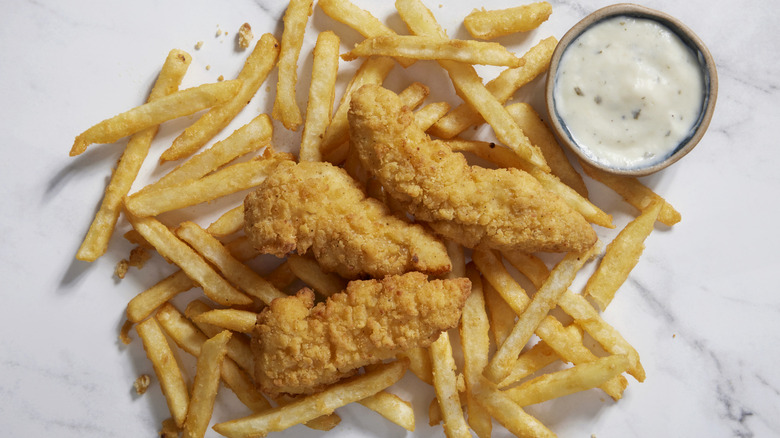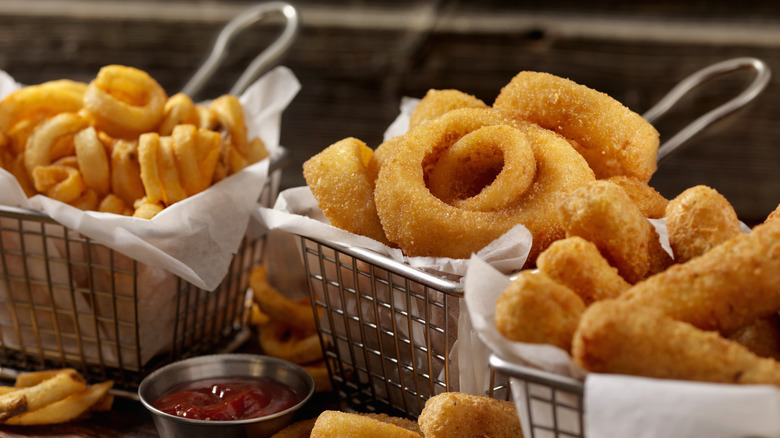Yes, There Is Really A Difference Between Crispy And Crunchy
"This recipe really gives your chicken a crispy and crunchy exterior!"
"If you want a crunchy and crispy texture, make sure to keep the temperature at a consistently hot temperature."
You've most likely heard some variation on these previous statements before. Maybe it's in a recipe for making homemade fried chicken or you're trying to figure out how to keep your deep-fried food from becoming a soggy mess, but it's almost all the same; promises of giving your food a "crispy" and "crunchy" texture instead of something that reminds you of chewing on a breaded rubber band. Those recipes use the words crispy and crunchy so much that they almost sound interchangeable, as if it's just someone repeating the same term over and over again. It's kind of like saying your dinner was delicious and palatable — you basically just said the same thing twice to look sophisticated.
Crispy and crunchy, on the surface, sound like the same concept, just rehashed with different words. But what if you found out that these two words, used so frequently in everything from cookbooks to reality cooking shows, actually do mean two different things? What if both crispy and crunchy are indeed very similar, but also different in certain ways? The differences between something that is crispy (i.e. the skin of a roast chicken) and crunchy (i.e. a handful of kettle-cooked potato chips) actually lie within their texture, weight, and even their sounds.
Crispy foods are lighter and more delicate
Let's say that you're eating a plate of chicken wings. It doesn't matter what flavor they are, but it's important that they aren't the breaded kind. When you take a bite of the chicken wing, you'll notice that the skin has developed a very light, delicate texture, one that offers some resistance and firmness when you bite down into it. It's not too hard, but it has enough of a texture to give it that sense of being "shatteringly" crisp.
Something that is crispy can usually be described as something that is very thin and very light, making it incredibly breakable under the slightest form of pressure. Some good examples of crispy foods can include the tempa you may find on meats or seafood, oven-baked potato chips, or, in some cases, the thin crust of a pizza. Crispiness should be something that doesn't take much resistance to break, something that makes that trademark snapping or cracking sound without being too dense. When you're eating something like fried vegetables, you'd want the breading or coating to be light instead of heavy and thick.
Consider McDonald's famously crisp McNuggets. While the tempura coating on them is fried to a golden color, it's also firm enough to provide a pleasant contrast to the moist and chewy meat on the inside, yet light enough that it doesn't feel like you're mainly chewing on breading.
Crunchy refers to things that are denser
You're at a barbeque and you notice someone bought a big tray of fried chicken from the grocery store. You know, that big plastic tray full of fried chicken that's fresh from the grocery store deli? You grab a thigh and you take a big bite — just listen to that crunch! That thick, hefty breading breaks apart under your teeth, making a loud crunch, loud enough that the person next to you can hear it. That's the trademark sound of something crunchy.
Compared to crispy foods, crunchier foods are heavier and usually rely more on a large amount of breading or their natural texture to provide that dense, loud cracking sound. Some examples of crunchy foods can include raw vegetables like celery and carrots, kettle-cooked potato chips, onion rings, fried chicken, cookies, and burnt pizza. While crispy foods are usually drier, crunchy foods can also be wet or moist, but are usually dried in order to provide maximum "crunch." Unlike the gentle sound of crisp skin breaking, the sound of something crunchy (like a carrot snapping or a pickle being bitten) makes an audible, distinct sound, similar to branches breaking or gravel being stepped on. You can get a crisp snapping sound when you fry up some French fries, but you'll get a deep crunching sound when you bite into double-battered fried chicken.
Remember, if it's light and thin, it's crispy then. If it's dense and golden brown, you're in crunchy town.


